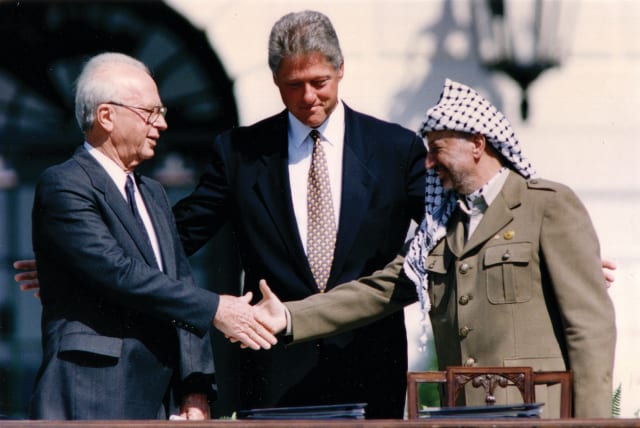Now is the time to recognize Palestinian statehood - opinion

This madness must stop, and nothing will stop it unless Israel and the Palestinians agree on a two-state solution.
In a recent article, I argued that the two-state solution is the only viable option to bring closure to the Israeli-Palestinian conflict. Not surprisingly, the reaction of many of those who read it fell generally into four categories. One group argued that this is not the right time, given the Israel-Hamas war, and it will take another generation before Israelis and Palestinians can reconcile and begin peace talks. The second argument is that the Palestinians will never accept Israel’s right to exist even if they establish a state of their own, as they are bent on Israel’s destruction. The third category believes that the whole idea of a two-state solution is akin to satire and does not warrant serious consideration. The final group argues that the conflict is endemic and irreconcilable, and thus, the whole notion of a two-state solution is illusionary and will never happen.
What is troubling about these views is the resignation that any renewed peace negotiation will be futile because everything that has been tried before to reach a peace agreement did not work.
I vehemently disagree because until they face their current disastrous reality, this conflict, which has already inflicted so much death and destruction on both sides over the past 75 years, simply will never go away and will continue to haunt them for generations.
When is the right time?
To those who claim that this is not the right time, I ask, when is the right time?
Do the Israelis and Palestinians need more time to inflict hundreds of thousands more casualties before waking up to their tragic existence? More time to poison another four generations with enmity and venom toward the other? More time to dehumanize the other, to make the killing and savagery of innocent people casual? More time to squander billions for training, procuring military hardware, and preparing the young to die in the next war? More time to conspire and collude to terrorize the other? More time for millions to suffer, feel threatened, and live in fear and agonizing uncertainty? More time to deepen the hatred, animosity, and distrust to make reconciliation impossible? And more time to shatter the dream of the vast majority on both sides to live in peace and security?
Now is the time to end the conflict because more time will make it even more intractable and exact an ever-higher price in blood and precious resources, and as the conflict continues, they will still face one another in war or in peace because their coexistence in one form or another is inescapable.
To those who claim that the Palestinians are bent on Israel’s destruction, I say, yes, there are indeed many extremist Palestinians, such as Hamas and Palestinian Islamic Jihad (PIJ), who are committed to Israel’s destruction and will not abandon their plan to destroy Israel even if the Palestinians establish a state of their own. But then, 75 years later, they have nothing to show for it. There is no Palestinian state and they are subjected to occupation under which they are losing ground every passing day. They never had the means to pose a clear and present danger to Israel and will never acquire a military edge over Israel. The Israel-Hamas war is only demonstrating Hamas’ calamitous miscalculation, as their savagery of innocent Israelis will end up eviscerating their movement to the point of no return.
Surely, there will still be fanatics who revel in self-deception, believing they can destroy Israel, but here is where it will end in self-deceit. The Palestinian Authority (PA); a multitude of Palestinian moderates; and the leading Arab states have long since accepted Israel’s existence. This goes back to the Arab Peace Initiative in 2002, representing a major transformation from the Arab League’s Khartoum Resolution of September 1967, known for its “three Nos” – no negotiation, no recognition, and no peace. The Abraham Accords further attest to the Arab states’ attitude toward Israel, which has not been lost on the Palestinians. Even Hamas’ own charter, updated in 2017, accepts a Palestinian state based on the 1967 borders – a recognition, albeit implicit, that Israel does and will continue to exist.
Others who read the article refer to the idea of a two-state as “satire” and intimate that only the naïve would still advocate for such a foolish proposal. I do not find the continuing death of Israelis and Palestinians by the thousands funny; nor do I view the indiscriminate killing of Israeli men, women, and children by Palestinian terrorists as amusing. I do not think that the occupation and the frequent Palestinian casualties in the West Bank are a laughing matter; nor do I find the horrifying savagery and mutilation of women by Hamas hysterical. I do not believe wars that cause so much havoc, destruction, tragic loss of life, and starvation of children are humorous, nor do I see the continuing suppression of Palestinians under occupation as comical. I do not find the indoctrination of Palestinian youth to hate and violently resist the Israelis hilarious, nor do I find the Israelis’ view that the Palestinians are a perpetual mortal enemy, entertaining.
This madness must stop, and nothing will stop it unless Israel and the Palestinians agree on a two-state solution. However doubtful many on both sides are about such an end-game, no one has come up as yet with a realistic alternative to end four generations of bloody conflict.
Finally, there are those who claim that the two-state solution is nothing but an illusion that will never come to pass simply because neither Israel nor the Palestinians will ever agree to share the land from the Mediterranean to the Jordan River, which each considers to be exclusively theirs.
To make their case, they submit that for the past seven decades, nothing has worked – incentives, compromises, pressure, persuasion, peace negotiations, the threat of violence, mediation, international conferences or UN resolutions, summits, or interim agreements – and there is nothing left that can facilitate a solution. For all they know, it is illusionary to think that the conflict could end with a two-state solution because it is endemic and has become an intrinsic module of Israeli and Palestinian DNA.
I disagree with this argument, which assumes that there are conflicts that simply cannot be resolved. There are ample examples of violent conflicts that ended peacefully.
Whereas past efforts to resolve the Israeli-Palestinian conflict have failed, sometimes it takes a major explosion to shake the dynamic of the conflict fundamentally.
Hamas’ unprecedented gruesome attack and Israel’s unparalleled retaliation have done exactly that. They dramatically upended the dynamic of the conflict and created new conditions between the two sides, making it impossible for them to simply return to the status quo ante, which has never been sustainable.
The ultimate defeat of Hamas as a political force offers a historic opportunity to end the Israeli-Palestinian conflict that must not be missed. Unlike at any other time in the past, the two-state solution is now back at the front and center of any future Israeli and Palestinian discourse and is seen as the only viable option. This will necessitate new, courageous, and visionary leaders on both sides to seize this generational opportunity.
It will, of course, take some time before both sides act, but the time of reckoning has arrived.
The writer is a retired professor of international relations, most recently at the Center for Global Affairs at NYU. He taught courses on international negotiation and Middle Eastern studies.
Jerusalem Post Store
`; document.getElementById("linkPremium").innerHTML = cont; var divWithLink = document.getElementById("premium-link"); if (divWithLink !== null && divWithLink !== 'undefined') { divWithLink.style.border = "solid 1px #cb0f3e"; divWithLink.style.textAlign = "center"; divWithLink.style.marginBottom = "15px"; divWithLink.style.marginTop = "15px"; divWithLink.style.width = "100%"; divWithLink.style.backgroundColor = "#122952"; divWithLink.style.color = "#ffffff"; divWithLink.style.lineHeight = "1.5"; } } (function (v, i) { });

